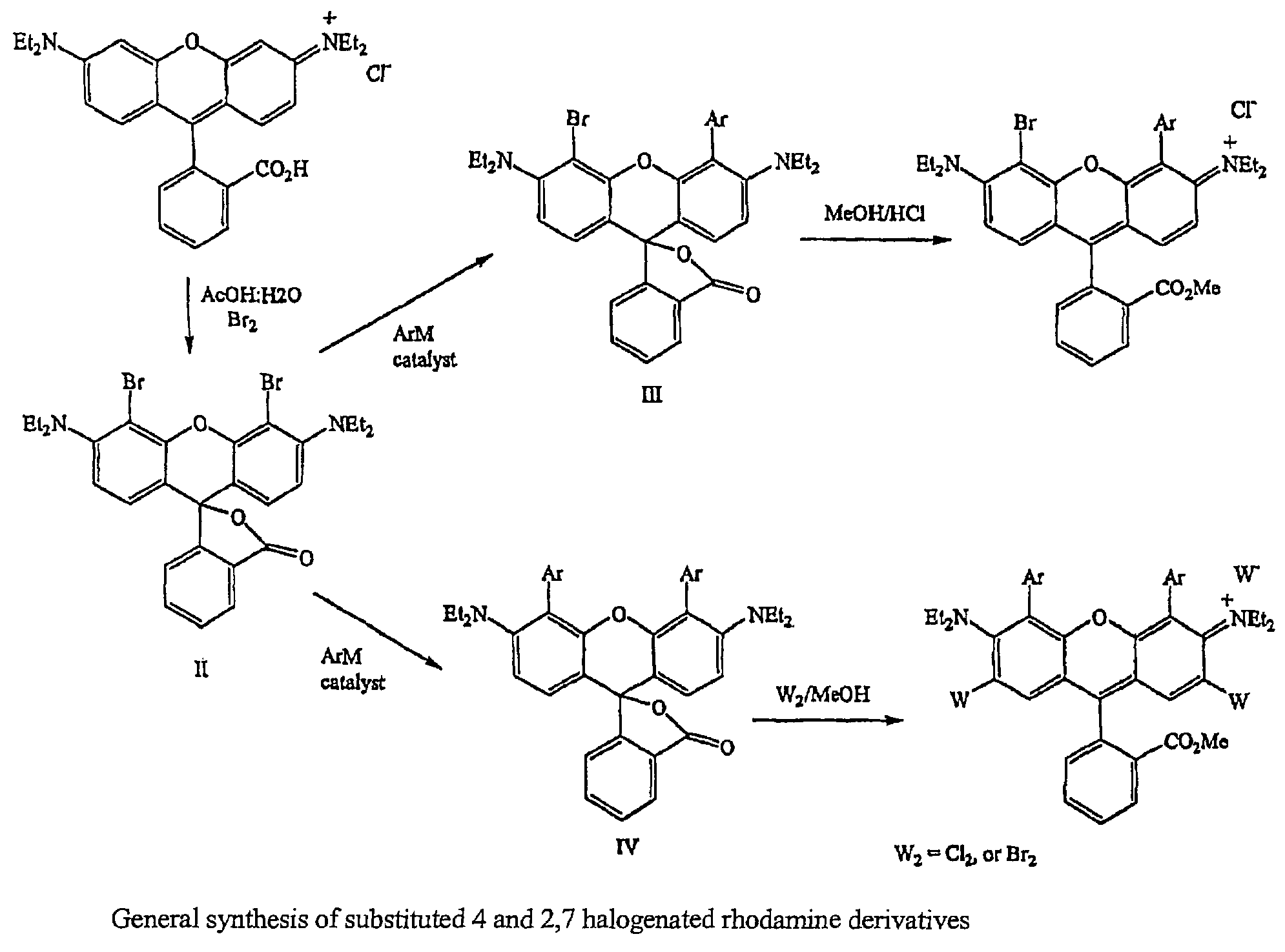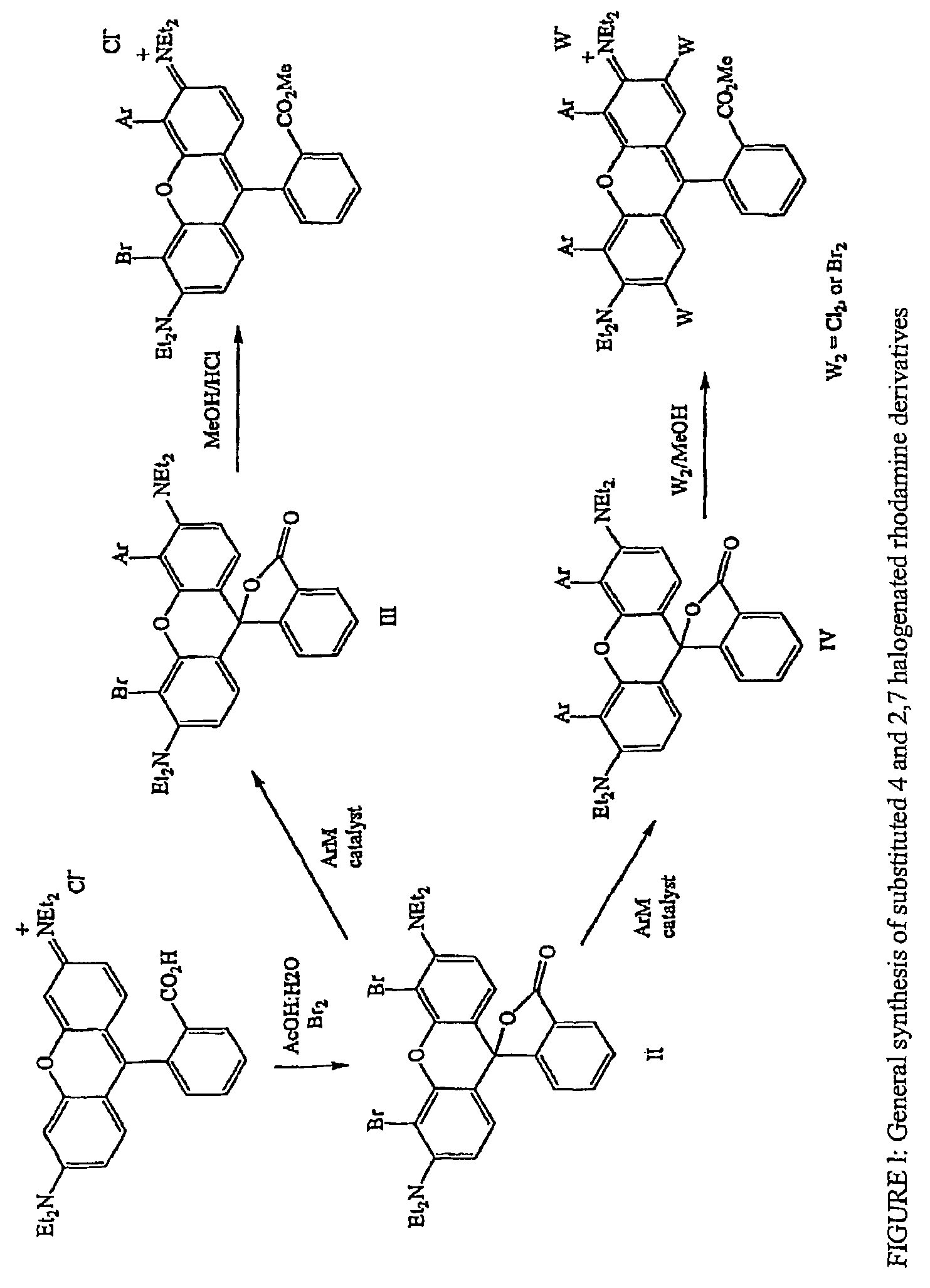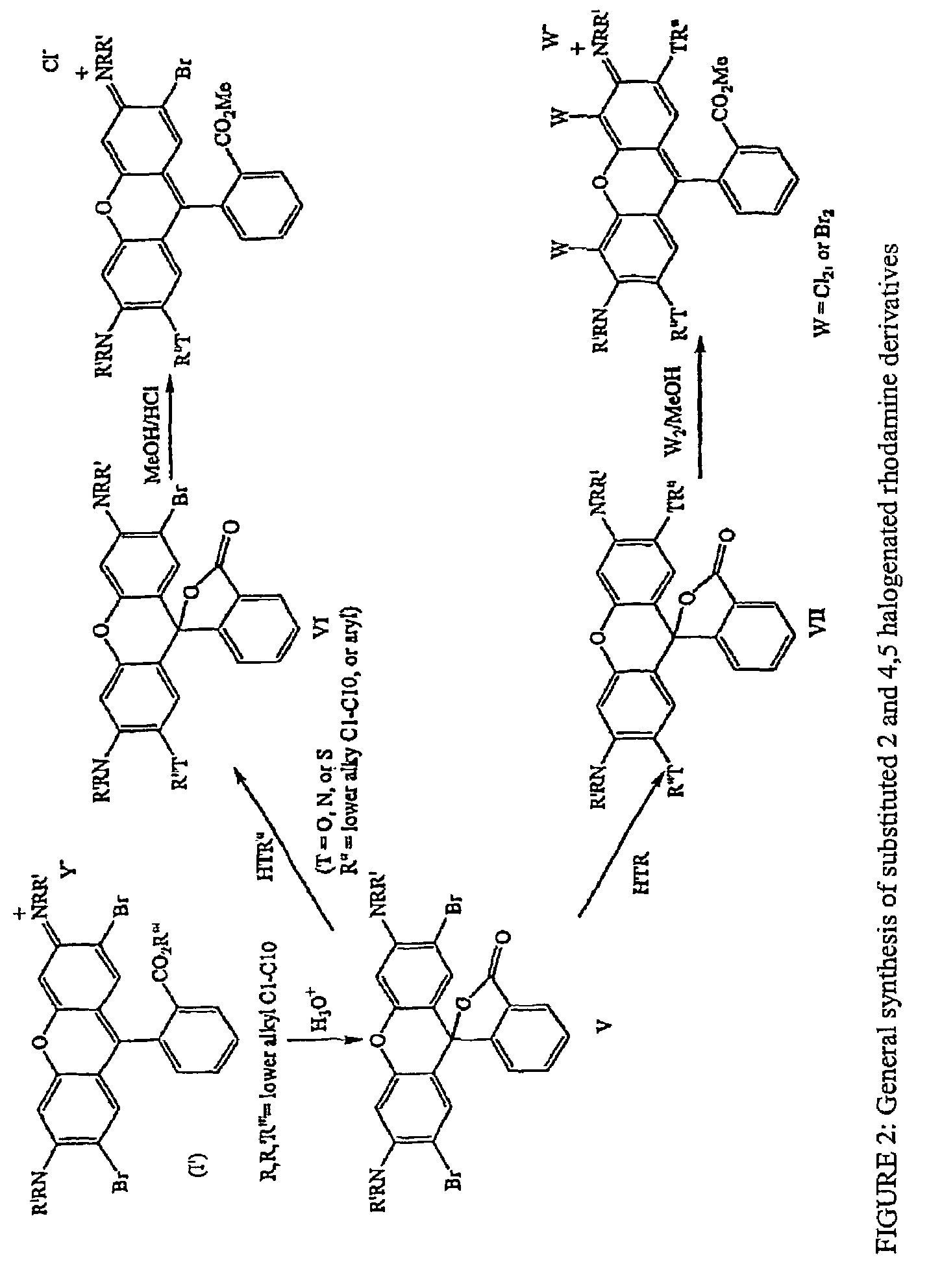Halogenated rhodamine derivatives and applications thereof
a technology of rhodamine and derivatives, applied in the field of new rhodamine derivatives, can solve the problems of cell death, insatisfactory techniques, blood components carrying risk of pathogen transfusion, etc., and achieve the effect of reducing
- Summary
- Abstract
- Description
- Claims
- Application Information
AI Technical Summary
Benefits of technology
Problems solved by technology
Method used
Image
Examples
example ii
II Synthesis of 2,7-dibromorhodamine B hexyl ester acetate salt (8)
II-1 Preparation of Rhodamine B hexyl ester (5)
[0288]
[0289]To a stirred mixture of 2.39 g (4.98 mmol) of Rhodamine B and 120 ml of 1-hexanol, hydrochloric acid was bubbled through the solution for 45 min and the reaction mixture was refluxed overnight. The 1-hexanol was then distilled under reduced pressure and the dark red residue was purified by flash chromatography using a mixture of methanol and dichloromethane (1:9) as eluent. After the evaporation of the volatile solvents we obtained a viscous red green residue (2.62 g).
[0290]Rf: 0.45 (MeOH:CH2Cl2 1.2:8.8)
[0291]Yield: 93.5%
[0292]Ms (FAB): Calculated C34H43O3N2 (M−Cl)+: 527.3273. Found: 527.3261.
[0293]UV(MeOH): λmax 555 nm
II-2 Preparation of dihydrorhodamine B hexyl ester (6)
[0294]
[0295]Rhodamine B hexyl ester (5) 940 mg (1.66 mmol) was dissolved in 200 ml of dichromethane and 150 ml of water. Excess NaBH4 (solid) was added in portion with vigorous stirring, dur...
example iii
III Synthesis of 2′-(6-dimethylamino-3-dimethylimino-3H-xanthen-9-yl)4′,5′-dichloro-benzoic acid methyl ester hydrochloride (10)
III-1 Preparation of 2′-(6-dimethylamino-3-dimethylimino-3H-xanthen-9-yl)4′,5′-dichloro-benzoic acid hydrochloride (9)
[0309]
[0310]A mixture of 3.00 g (21.8 mmol) of 3-(dimethylamino)phenol, 3.00 g (13.8 mmol) of 4,5-dichlorophtalic anhydride, and 1.72 g of zinc chloride is heated in an oil bath at 165-170° C. for 5 h 30 min with stirring. The melt is cooled and powdered to give a red solid. The solid is washed with hot water, triturated with 10% sodium hydroxide and diluted with water. The gum which separates is collected, washed with more sodium hydroxide and water. The resulting dye base is then triturated with concentrated hydrochloride acid. Water was then added and the red precipitate obtained was collected and dried. The dye was then dissolved in methanol and precipitated with diethyl ether to give 9 as red solid (3.27 g).
[0311]Rf: 0.48 (MeOH:CH2Cl2 2...
example iv
IV Preparation of 4,5-dibromorhodamine 6G (11)
[0323]
[0324]To a quantity of 600 mg (1.25 mmol) of rhodamine 6G dissolved in 50 ml of methanol was added dropwise, at room temperature, a solution of 128 μL (2 eq., 2.50 mmol) of bromine. A precipitate was formed 10 min after the addition of the bromine. The mixture was stirred for 3 hours, and the solvent was evaporated under reduced pressure to give a red solid. The crude was recrystallized from methanol:diethyl ether (80 ml:400 ml) to give the product 11 as green red solid (585 mg).
[0325]Rf: 0.26 (MeOH:CH2Cl2 1:9)
[0326]Yield: 68.5%
[0327]Nmr (CD3OD): δ8.36 (dd, J=1.13 and 7.44 Hz, 1H); 7.89 (m, 2H); 7.47 (dd, J=1.46 and 6.76 Hz, 1H); 6.98 (s, 2H); 4.07 (m, 6H); 2.29 (s, 6H); 1.28 (t, J=7.04 Hz, 6H); 1.02 (t, J=7.05 Hz, 3H)
[0328]Ms (FAB): Calculated for C28H30O3N2Br2 (MH−Br)+: 600.0623. Found: 600.0605.
[0329]UV (MeOH): λmax 546 nm
PUM
| Property | Measurement | Unit |
|---|---|---|
| total volume | aaaaa | aaaaa |
| total volume | aaaaa | aaaaa |
| volume | aaaaa | aaaaa |
Abstract
Description
Claims
Application Information
 Login to View More
Login to View More - R&D
- Intellectual Property
- Life Sciences
- Materials
- Tech Scout
- Unparalleled Data Quality
- Higher Quality Content
- 60% Fewer Hallucinations
Browse by: Latest US Patents, China's latest patents, Technical Efficacy Thesaurus, Application Domain, Technology Topic, Popular Technical Reports.
© 2025 PatSnap. All rights reserved.Legal|Privacy policy|Modern Slavery Act Transparency Statement|Sitemap|About US| Contact US: help@patsnap.com



